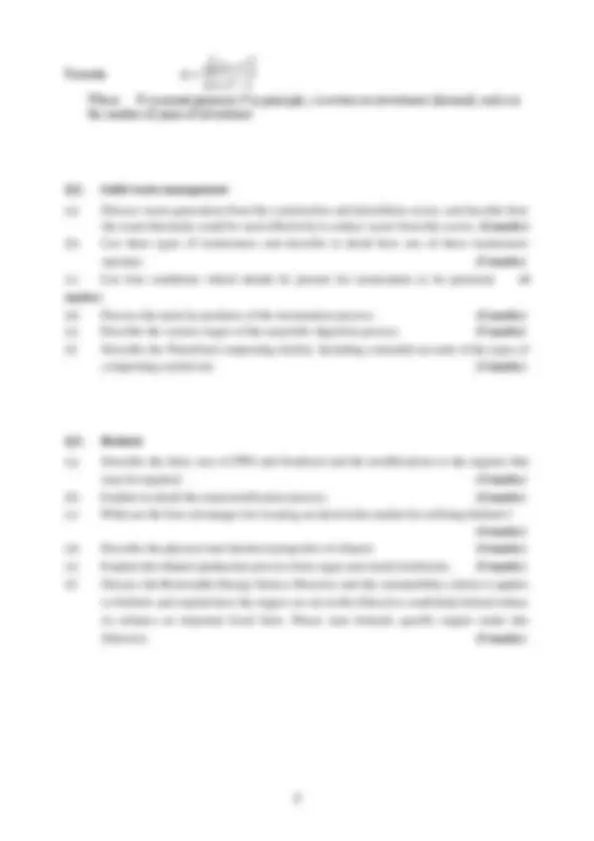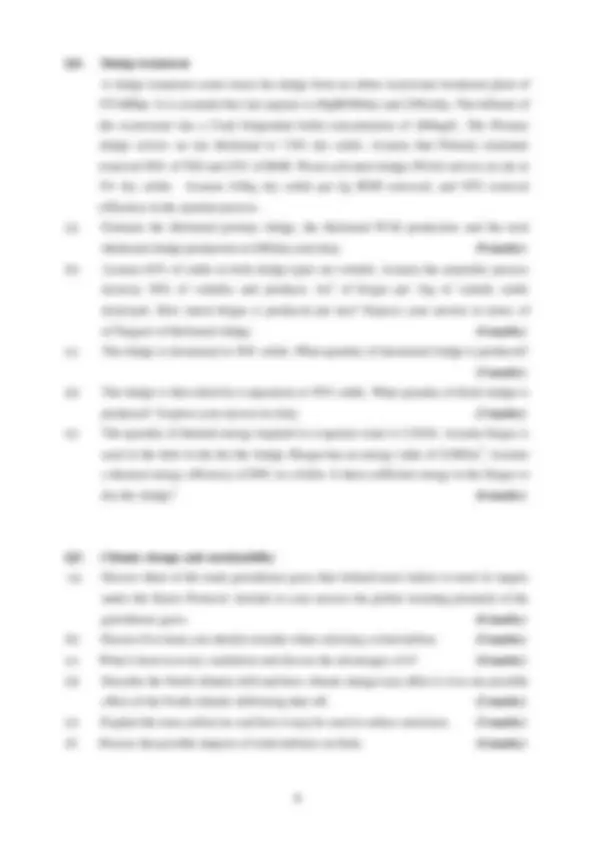




Study with the several resources on Docsity

Earn points by helping other students or get them with a premium plan


Prepare for your exams
Study with the several resources on Docsity

Earn points to download
Earn points by helping other students or get them with a premium plan
Community
Ask the community for help and clear up your study doubts
Discover the best universities in your country according to Docsity users
Free resources
Download our free guides on studying techniques, anxiety management strategies, and thesis advice from Docsity tutors
Information about an exam for the environmental and energy engineering module at the cork institute of technology. The exam covers topics such as biodegradable municipal waste treatment, solid waste management, biofuels, and sludge treatment. It includes questions on calculating energy production and export, waste reduction strategies, incinerator operation, anaerobic digestion, and ethanol production. The document also includes economic parameters and formulas.
Typology: Exams
1 / 4

This page cannot be seen from the preview
Don't miss anything!



Semester 1 Examinations 2010/
Module Code: CIVL
School: Department of Civil, Structural and Environmental Engineering
Programme Title: Bachelor of Engineering (Hons) in Structural Engineering Certificate in Environmental & Energy Engineering Bachelor of Engineering (Hons) in Sustainable Energy Technology
Programme Code: CSTRU_8_Y EENEN_8_Y ESENT_8_Y
External Examiner(s): Dr. M. Richardson Mr. J. O’Mahony
Internal Examiner(s): Dr. N. Power
Instructions: Answer any four question All questions carry equal marks
Duration: 2 Hours
Sitting: Winter 2010
Requirements for this examination:
Note to Candidates: Please check the Programme Title and the Module Title to ensure that you have received the correct examination paper. If in doubt please contact an Invigilator.
Q1. Treatment of biodegradable municipal waste An area has a population of 380,000pe. The MSW production is 640kg/pe, 43% of which may be sent to an anaerobic digestion facility. The biogas produced may be sent to either a CHP or transport system The destruction of 1kg of volatile solids results in the production of 1m^3 of biogas with an energy value of 21MJ/m^3 (55.5% CH 4 ). Biodegradable municipal waste has a dry solids content of 41%, a volatile solids content of 64%, with 52% of volatiles destroyed in the digester. Digestate is produced at 61% solids. In the CHP system electricity is produced at 37% efficiency and thermal energy is produced at 38% efficiency. The parasitic electrical demand is 29% and the parasitic thermal demand is 9%. In the transport system the electricity and heat required are the same as for the CHP system. However an additional electrical requirement for cleaning and compression of the biomethane is required. The additional electrical requirement equates to 0.7kWh/m^3 biomethane. Biogas heats the digester and the boiler operates at 80% efficiency.
Economic Parameter Quantity Capital cost of digester incl. CHP €257/tpa Capital cost of digester incl. scrubbing & compression €275/tpa Operating cost of digester incl. CHP €29/t Operating cost of digester incl. scrubbing & compression €38/t Cost of electricity €0.13/kWh Sale of electricity €0.12/kWh Sale of heat €0.02/kWh Sale of biomethane incl. VAT @21% €1.299/m^3 Sale of digestate €35/t
(a) How much energy in GJpa and digestate is produced from the digestion process? (4 marks) (b) How much electricity may be exported from the digester? Express your answer in kWhpa. If an average house uses 2628kWhpa, how many houses may be served? (4 marks) (c) How much thermal energy may be exported from the digester? Express your answer in kWhpa. If an average house uses 66GJpa of thermal energy, how many houses may be served. (4 marks) (d) Estimate the quantity of biomethane that could be produced from the transport system if the biomethane is cleaned to 95% methane (biogas heats digester). How many cars may be fueled by biomethane if 1m^3 = 1 liter of petrol and an average car uses 1130L of petrol? (4 marks) (e) The capital cost is spread over 20 years with a return on investment of 7%. Determine the minimum gate fee required (with the sale of digestate) for the CHP and transport system. (9 marks)
Q4. Sludge treatment A sludge treatment centre treats the sludge from an urban wastewater treatment plant of 475,000pe. It is assumed that 1pe equates to 60gBOD/day and 230L/day. The influent of the wastewater has a Total Suspended Solid concentration of 260mg/L. The Primary sludge arrives on site thickened to 7.0% dry solids. Assume that Primary treatment removed 50% of TSS and 25% of BOD. Waste activated sludge (WAS) arrives on site at 3% dry solids. Assume 0.6kg dry solids per kg BOD removed, and 95% removal efficiency in the aeration process. (a) Estimate the thickened primary sludge, the thickened WAS production and the total thickened sludge production in tDS/day and t/day. (9 marks) (b) Assume 65% of solids in both sludge types are volatile. Assume the anaerobic process destroys 50% of volatiles and produces 1m^3 of biogas per 1kg of volatile solids destroyed. How much biogas is produced per day? Express your answer in terms of m^3 biogas/t of thickened sludge. (4 marks) (c) The sludge is dewatered to 30% solids. What quantity of dewatered sludge is produced? (3 marks) (d) The sludge is then dried by evaporation to 95% solids. What quantity of dried sludge is produced? Express your answer in t/day. (3 marks) (e) The quantity of thermal energy required to evaporate water is 2.5GJ/t. Assume biogas is used in the drier to the dry the sludge. Biogas has an energy value of 21MJ/m^3. Assume a thermal energy efficiency of 80% in a boiler. Is there sufficient energy in the biogas to dry the sludge? (6 marks)
Q5. Climate change and sustainability (a) Discuss three of the main greenhouse gases that Ireland must reduce to meet its targets under the Kyoto Protocol. Include in your answer the global warming potential of the greenhouse gases. (6 marks) (b) Discuss five items you should consider when selecting a wind turbine. ( 5 marks) (c) What is heat recovery ventilation and discuss the advantages of it? (4 marks) (d) Describe the North Atlantic drift and how climate change may affect it. List one possible effect of the North Atlantic drift being shut off. (3 marks) (e) Explain the term carbon tax and how it may be used to reduce emissions. (3 marks) (f) Discuss the possible impacts of wind turbines on birds. ( 4 marks)